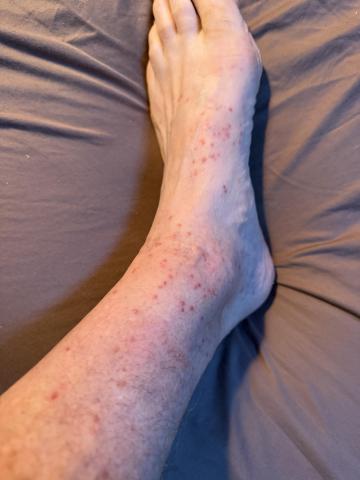Chiggers
By Steve Roark
Volunteer Interpreter, Cumberland Gap National Historical Park
Occasionally you pay a price for being in the woods, especially if you go off trail as I often do. I recently got hammered with chigger bites, especially around my ankles and feet. They are almost microscopic yet pack a wallop of misery.
Chiggers are a species of mite in the larval stage. They are too small to see with the naked eye, and under a microscope look sort of like tiny ticks. The adults, which can be seen, feed only on plants and are not a problem for us, except for their laying eggs that make more baby chiggers.
A baby chigger wants to become an adult chigger, and to do so it needs a high protein meal like a human or other mammals, which requires a lot of patience and fast reflexes to pull off. Chiggers hang around on grass, weeds, or brush for weeks waiting for something to walk by. When they sense air movement or a whiff of carbon dioxide, they get ready and then grab onto whatever brushes by. They will then poke around looking for a good spot to feed, preferring warm places where skin and clothes are close together, such as waistlines or under socks.
To feed, the larval chigger gets a good grip with using claws and attaches its mouth to the skin, then injects a saliva with an enzyme that breaks down skin cells to a liquid form. Your body responds by hardening skin cells around the saliva, which forms a tube, which makes it easy for the chigger to suck up the liquified skin cells. Feeding can go on for about four days, then they drop off. Normally when you get into a nest of chiggers you will receive several bites.
The most obvious symptom is the intense itching that starts when the chigger saliva has bored down to live skin cells. The infected area will eventually form reddish bumps that remain for a week or more. Thankfully bites don’t cause any serious harm or transmit disease, but the itching can be so bad that over-vigorous scratching can become infected. About all you can do is use anti-itch medications like calamine lotion or hydrocortisone.
Avoiding chigger attacks is not easy since they can be almost anywhere. Applying insect repellent containing DEET is usually effective. Chiggers tend to congregate in tall grass and weedy areas, so you might steer clear of those spots if you can. These overgrown areas often grow a pretty white flowering plant with lacy leaves called Queen Anne's lace, which most folks around here call "Chigger Weed".
- Log in to post comments
